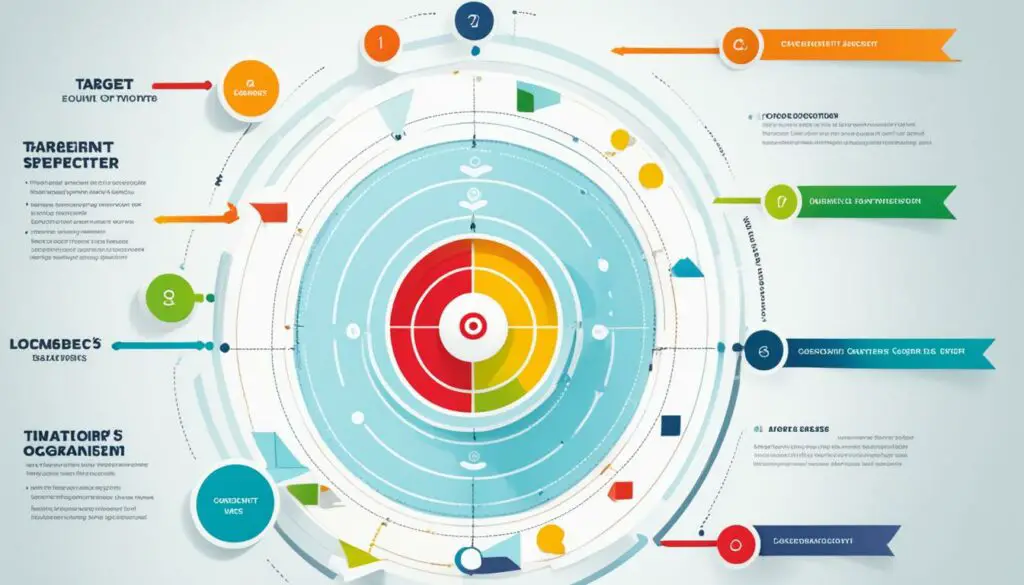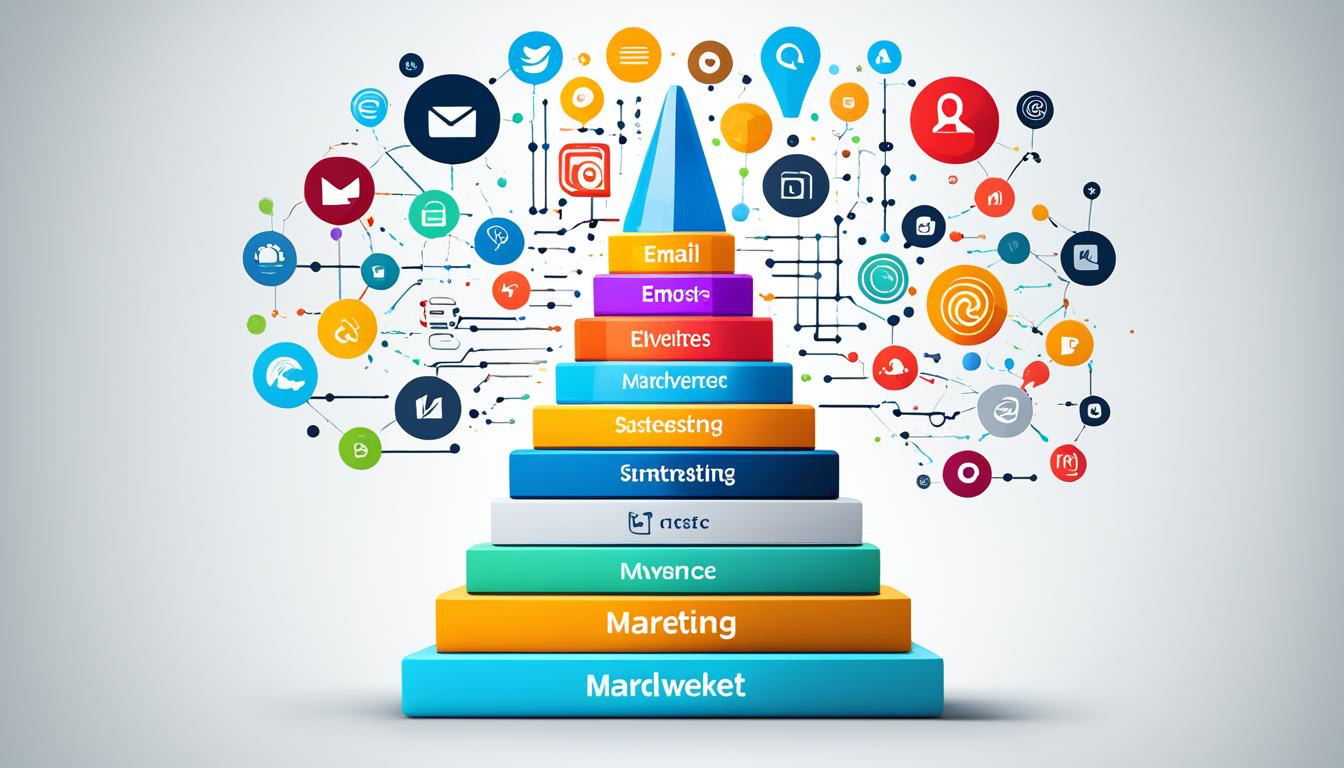Welcome to our comprehensive guide on differentiated vs undifferentiated marketing strategies. In today’s highly competitive business landscape, understanding the importance of targeting the right audience and establishing a competitive advantage is crucial. By delving into concepts such as market segmentation, brand identity, customer engagement, and the marketing mix, we will explore the key differences between these two approaches and their impact on consumer behavior.
Key Takeaways:
- Differentiated marketing tailors campaigns to specific audience segments.
- Undifferentiated marketing takes a broad approach to reach the entire target market.
- Both strategies have advantages and disadvantages.
- Undifferentiated marketing can be cost-effective and reach a wide audience.
- However, it may lack personalized customer engagement and be vulnerable to market changes.
What is Undifferentiated Marketing?
Undifferentiated marketing is a broad approach that involves creating a single campaign to reach the entire target market. This strategy aims to appeal to a universal audience by delivering an inclusive message that resonates with a wide range of consumers. Undifferentiated marketing is often employed for products with broad appeal, such as everyday essentials like toothpaste or soap.
| Advantages of Undifferentiated Marketing | Disadvantages of Undifferentiated Marketing |
|---|---|
| 1. Cost-effective: Creating a single campaign can be more cost-effective compared to developing multiple targeted campaigns. | 1. Vulnerability to market changes: Undifferentiated marketing may struggle to adapt to evolving market trends and consumer preferences. |
| 2. Broad reach: By appealing to a universal audience, undifferentiated marketing allows businesses to reach a wide range of potential customers. | 2. Competition: Generic campaigns may face stiff competition from competitors that offer personalized and targeted marketing strategies. |
| 3. Brand recognition: Creating a single campaign helps build brand awareness and recognition for products that are used by everyone. | 3. Lack of customer loyalty: Without personalization, it can be challenging to foster customer loyalty and repeat purchases. |
Advantages of Undifferentiated Marketing
Undifferentiated marketing offers several advantages that can benefit businesses, making it a viable strategy to consider.
Cost-Effective
One of the key advantages of undifferentiated marketing is its cost-effectiveness. By creating a single marketing campaign for the entire target market, businesses can save valuable resources and effort. This approach eliminates the need for developing multiple customized campaigns for different segments, reducing expenses associated with market research, content creation, and campaign management.
Broad Reach
Undifferentiated marketing allows businesses to reach a wide audience. By targeting the entire market, companies can maximize their reach and exposure, ensuring that their message reaches a large number of potential customers. This broad approach is particularly effective when promoting products or services that have wide-reaching appeal and are used by a diverse range of consumers.
Brand Recognition
Another advantage of undifferentiated marketing is its potential to build strong brand recognition. By consistently delivering a unified message to the market, businesses can establish a strong brand presence and familiarity among consumers. When consumers encounter a brand repeatedly, it enhances brand recall and increases the likelihood of them choosing that brand when making purchasing decisions.
| Advantages of Undifferentiated Marketing |
|---|
| Cost-Effective |
| Broad Reach |
| Brand Recognition |
Disadvantages of Undifferentiated Marketing
Undifferentiated marketing, despite its broad appeal, comes with several disadvantages that businesses should consider before adopting this approach. One of the main drawbacks is its vulnerability to market changes. Since undifferentiated marketing targets a universal audience with a single campaign, it may struggle to adapt to changing market trends and consumer preferences. This can result in a loss of relevance and potential customers shifting towards competitors who offer more personalized and targeted campaigns.
Furthermore, the lack of customization and personalization in undifferentiated marketing makes it challenging to compete in highly competitive markets. With competitors leveraging targeted marketing approaches, businesses utilizing undifferentiated marketing may find it difficult to differentiate themselves and effectively attract and retain customers.
Another significant disadvantage is the difficulty in cultivating customer loyalty with a generic product. Without personalized messaging and tailored experiences, customers may not feel a strong connection to the brand or perceive any unique value in choosing one product over another. This lack of customer loyalty can further limit the long-term growth and success of businesses relying solely on undifferentiated marketing strategies.
Overall, while undifferentiated marketing has its benefits, such as cost-effectiveness and broad reach, it is essential for businesses to be aware of its disadvantages and carefully assess whether it aligns with their goals, target audience, and competitive landscape.
Differentiated vs. Undifferentiated Marketing
When deciding on the marketing strategy to adopt, businesses need to carefully consider whether differentiated or undifferentiated marketing would be more suitable for their needs. Factors such as product suitability, budget considerations, and brand image play a crucial role in determining the most effective approach.
Differentiated marketing involves tailoring campaigns to specific segments of the target audience. This strategy is suitable for products that cater to distinct customer preferences or narrow demographics. By customizing marketing mixes for different segments, businesses can effectively engage with their target market and establish a competitive edge.
On the other hand, undifferentiated marketing takes a broader approach by creating a single campaign to reach the entire target market. This strategy is often used for products with wide-reaching appeal, such as everyday essentials like toothpaste or soap. By adopting an inclusive message, businesses aim to capture a universal audience.
When deciding between differentiated and undifferentiated marketing, businesses must evaluate the suitability of their product for targeting specific segments. Some products may have unique features or benefits that resonate with a particular subset of customers, making differentiated marketing a better choice. Additionally, budget considerations play a significant role in determining the feasibility of implementing a personalized and targeted marketing approach.
Another important factor to consider is brand image. Different marketing strategies convey different brand identities. While differentiated marketing emphasizes customization and personalization, undifferentiated marketing focuses on mass appeal and broad reach. Therefore, businesses must evaluate which approach aligns better with their desired brand image and overall marketing goals.
By carefully analyzing product suitability, budget considerations, and brand image, businesses can make an informed decision about whether differentiated or undifferentiated marketing is the best strategy for their specific needs. The chosen approach will determine how the product is positioned, promoted, and ultimately received by the target market.
By visually representing the differences between differentiated and undifferentiated marketing, this table highlights the contrasting aspects of these two strategies:
| Differentiated Marketing | Undifferentiated Marketing |
|---|---|
| Targets specific market segments | Aims to reach the entire target market |
| Customized marketing mixes | Single campaign for all segments |
| Narrower reach but higher customer engagement | Broader reach but lower customer engagement |
| Higher costs due to segmentation and customization | Lower costs due to a single campaign |
| Enhances brand differentiation | Builds brand recognition |
Examples of Undifferentiated Marketing
Undifferentiated marketing can be a powerful strategy for reaching a wide audience and establishing brand recognition. Several well-known companies have successfully implemented this approach to attract consumers on a mass scale. Let’s take a look at some prominent examples:
Coca-Cola
Coca-Cola is a prime example of how undifferentiated marketing can create a global phenomenon. The iconic brand’s marketing campaigns consistently appeal to a broad audience, using universal themes such as happiness and togetherness. By targeting consumers of all ages and backgrounds, Coca-Cola has become a household name synonymous with refreshing beverages.
M&M’s
M&M’s, the popular candy brand, has also adopted an undifferentiated marketing strategy to capture the hearts and taste buds of a diverse consumer base. With its fun and colorful characters and the tagline “Melts in your mouth, not in your hand,” M&M’s appeals to people of all ages and demographics. Through memorable advertising campaigns showcasing the candy’s vibrant packaging and enjoyable taste, M&M’s has become a beloved treat worldwide.
Colgate
Colgate, a leading oral care brand, relies on undifferentiated marketing to promote its range of toothpaste, toothbrushes, and other dental products. By creating campaigns that emphasize the importance of oral health for everyone, regardless of age or background, Colgate has successfully established itself as a trusted name in dental care. The brand’s universal appeal and strong market presence demonstrate the effectiveness of undifferentiated marketing in the consumer goods industry.
General Motors
General Motors, a renowned automobile manufacturer, has utilized undifferentiated marketing to showcase its diverse range of vehicles. Whether targeting families, young professionals, or adventure enthusiasts, General Motors’ advertising campaigns aim to resonate with a broad audience. By highlighting the features and benefits of their various car models, General Motors has successfully positioned itself as a leading player in the automotive industry.
These examples illustrate the power of undifferentiated marketing in reaching and engaging a broad range of consumers. By appealing to the universal needs and desires of their target market, companies like Coca-Cola, M&M’s, Colgate, and General Motors have achieved remarkable success in building brand awareness and loyalty on a large scale.
Target Market and Segmentation
The success of any marketing strategy relies heavily on understanding the target market and implementing effective segmentation tactics. The target market refers to the group of consumers who may have a need for a particular product or service. To effectively reach this diverse group, businesses employ segmentation techniques to divide the target market into smaller, homogeneous groups with distinct needs, preferences, and characteristics. Segmentation allows businesses to tailor their marketing efforts and create customized strategies for each segment, ultimately enhancing their chances of success.
Segmentation involves analyzing various factors such as demographics, socio-economic status, geographic location, psychographics, and behavior patterns. By categorizing the target market into manageable segments, businesses can develop targeted marketing initiatives that resonate with specific customer groups, leading to improved customer engagement and higher conversion rates.
The marketing mix plays a critical role in segment-based strategies. The marketing mix comprises the four Ps: product, price, placement, and promotion. Each element of the marketing mix is tailored to suit the needs and preferences of each segment. For example, the product offering may be customized to cater to specific segment requirements, the price may be adjusted to align with segment purchasing power, the placement channels may be targeted to reach specific segment locations, and the promotion strategies may be designed to appeal to the preferences and interests of each segment.

Implementing an effective target market and segmentation strategy allows businesses to align their products or services with the needs and desires of different customer segments. By catering to specific segments, businesses can maximize their relevance and appeal, improve customer satisfaction, and gain a competitive advantage in the market.
Differentiated Marketing Strategy
Differentiated marketing is a targeted approach that focuses on specific market segments by designing customized marketing mixes tailored to meet their unique needs. This strategy is particularly effective for products that cater to narrow demographics or have distinct customer preferences. By understanding the distinct characteristics and preferences of different market segments, businesses can develop targeted marketing campaigns that resonate with their target audience.
One key advantage of differentiated marketing is the ability to create personalized marketing messages and offerings that directly address the needs and desires of specific customer segments. By doing so, businesses can position themselves as experts in catering to the unique requirements of their target market, leading to increased customer satisfaction and loyalty.
For example, a luxury fashion brand may use differentiated marketing to target high-income individuals who value exclusivity and premium quality. The brand can develop marketing strategies that highlight the uniqueness and craftsmanship of their products, along with personalized customer experiences and tailored promotions.
In contrast, undifferentiated marketing takes a broader approach, targeting the mass market as a whole. While undifferentiated marketing may be suitable for products with wide-reaching appeal, differentiated marketing allows businesses to focus their efforts and resources on specific market segments that are most likely to be interested in their offerings.
Benefits of Differentiated Marketing Strategy:
- Enhanced customer engagement and satisfaction
- Effective utilization of resources
- Opportunity for premium pricing
- Improved brand loyalty and advocacy
By adopting a differentiated marketing strategy, businesses can achieve a competitive advantage by aligning their offerings with the specific needs and preferences of their target audience. This strategy allows for deeper customer relationships and stronger brand positioning within specific market segments.
Next, we will explore real-world examples of differentiated marketing strategies implemented by successful brands. By examining these examples, we can gain insights into the effectiveness of this strategy in capturing the attention and loyalty of specific market segments.
Conclusion
When it comes to marketing strategies, the choice between differentiated and undifferentiated approaches requires careful consideration of various factors. The nature of the product, budget constraints, and desired brand image all play a crucial role in determining the most effective strategy.
Differentiated marketing, with its focus on specific market segments and tailored marketing mixes, is ideal for products that cater to narrow demographics or distinct customer preferences. By engaging with these segments in a personalized way, businesses can create stronger brand differentiation and build lasting customer relationships.
On the other hand, undifferentiated marketing, with its broad and inclusive approach, can be highly cost-effective and effective for reaching a wide audience. This strategy works well for products with mass appeal and aims to establish brand recognition among consumers.
Ultimately, there is no one-size-fits-all solution. Businesses may find themselves transitioning between differentiated and undifferentiated marketing as their marketing goals evolve, and customer preferences change. It is essential to continuously analyze the market, monitor consumer behavior, and adapt marketing strategies accordingly to stay competitive and maintain customer engagement.
FAQ
What is the difference between differentiated and undifferentiated marketing?
Differentiated marketing involves tailoring campaigns to specific audience segments, while undifferentiated marketing takes a broader approach with one campaign to reach the entire target market.
What is undifferentiated marketing?
Undifferentiated marketing is a strategy that appeals to a universal audience by creating one campaign to reach the entire target market.
What are the advantages of undifferentiated marketing?
Undifferentiated marketing can be cost-effective and allows businesses to reach a wide audience and build brand recognition.
What are the disadvantages of undifferentiated marketing?
Undifferentiated marketing is vulnerable to market changes, may struggle to keep up with competitors, and can be challenging to cultivate customer loyalty.
How do differentiated and undifferentiated marketing strategies compare?
Differentiated marketing targets specific market segments with customized marketing mixes, while undifferentiated marketing takes a broader approach. The choice between the two depends on product suitability, budget considerations, and brand image.
Can you provide examples of brands that have used undifferentiated marketing successfully?
Examples of brands that have successfully used undifferentiated marketing include Coca-Cola, M&M’s, Colgate, and General Motors.
What is the target market and segmentation?
The target market is the group of consumers who might have a need for a product or service. Segmentation divides the target market into groups with different needs.
What is a differentiated marketing strategy?
Differentiated marketing targets specific market segments with customized marketing mixes designed to meet their unique needs.
What should businesses consider when choosing between differentiated and undifferentiated marketing?
Businesses should consider factors such as product suitability, budget, and brand image when deciding between differentiated and undifferentiated marketing strategies.
What is the importance of brand differentiation and customer engagement?
Brand differentiation and customer engagement play a crucial role in the success of marketing strategies, as they help businesses stand out from the competition and build strong relationships with their target audience.







